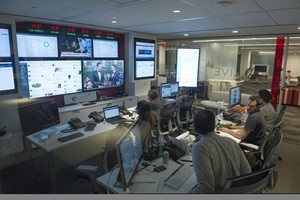Content Studios Are Poised For a Remarkable Bloom in 2018
For a long time, the term of digital marketing was tightly associated with banners, pop-ups,  footers, heaters, and the effectiveness of it was gauged by unengaged clicks, useless impressions, and social media shares where people keep posting links to articles that they actually have never even read beyond the headlines. In recent years, marketers have shifted their focus from the ad-driven business model, where the only thing that matters is whether a web page stayed open long enough to make money, to content marketing, where marketers focus on cultivating a meaningful engagement with the target audience through interactive content. This extremely successful and long-lasting impact of content marketing, further, drove brands to act more like publishers, and that’s how in-house content studios were born.
footers, heaters, and the effectiveness of it was gauged by unengaged clicks, useless impressions, and social media shares where people keep posting links to articles that they actually have never even read beyond the headlines. In recent years, marketers have shifted their focus from the ad-driven business model, where the only thing that matters is whether a web page stayed open long enough to make money, to content marketing, where marketers focus on cultivating a meaningful engagement with the target audience through interactive content. This extremely successful and long-lasting impact of content marketing, further, drove brands to act more like publishers, and that’s how in-house content studios were born.
Gone are the days of publishing a couple of multimedia content items here, or a few blog posts there. Today, marketing is a whole new world as marketers are taking on more of a strategic role than being just a tactical support. Today, the digital content world is floating on daunting yet abundant waters. With the advent of technology, it may be a great time to be a digital content marketer but it is hard to say the same for garnering attention from a target audience. Marketers, now, are tasked with leveraging customer engagement at each step of the customer cycle, and the way of engaging with a target audience varies at each step of a customer’s lifecycle. While this alone is a hard task, the bigger challenge is the rapidly increasing demand for consumer attention. As it’s not been scientifically proven that consumer attention capacity is also emerging, the competition for capturing attention is getting more fierce.
Content studios may be even called “brand journalism” because they produce content in an editorial manner. The main purpose for the content creators at those studios is to excel at telling a compelling story that resonates with the target audience. To do so, they generate a variety of content types, from articles, photography, and social posts to videos, podcasts, live streaming events, and immersive virtual reality experiences. The key to their success is to thoroughly understand both the marketing message and target audience.
The emerging new technologies such as AI-powered analytics or advanced marketing automation will help marketers create and scale their content. However, harnessing the creative side of the content curation process will be the differentiating point. The reason is that the technology automates and optimizes what is already known through putting it in the most meaningful and systematic way. With the ever-rising influence of machine learning and artificial intelligence, having this type of technology in place has become essential and mainstream. However, it also means that your rival can get more or less the same results if they have the same technology and similar sets of data. In this case, no one has the edge. Humans, on the other hand, can create unique ideas and knit them with their already developed logical and rational process. To back this point up, HSBC’s former head of marketing in EMEA Philip Mehl declared in an interview: “Marketing used to be a creative challenge but it’s a data challenge now.” Mehl also claimed that brands today primarily compete on how well they can target consumers, rather than on the quality of their ideas.
So the best results don’t come to battle for supremacy between machines and humans, but the collaboration of both - incorporating the benefits of the technology into human beings’ creativity.
The main factor that gave birth to creating content studios was actually driven by the common mishandling of branded content. After continuously spending a tremendous ad budget to hire rock stars, brands have finally realized that outspending is no longer taking organizations to the next level but, outmaneuvering can go a long way. How does a content studio provide this, you may ask? Here are some factors that you should take into consideration while looking for a content studio in order to drive some desired business outcomes:
-
It should be armed with a team that has expansive content experience and knowledge of diverse storytelling.
-
It should have an inspiring, collaborative, and diverse environment of its own.
-
The content creators in that environment should have a sophisticated sense of what really is valuable and meaningful to a target audience.
-
They should be challenging brands’ assumptions by their diverse opinions in order to breathe new life into their existing content strategies.
Pure-Play Content Studios or Media Companies?
Pure-Play
This type of content studio acts like a content creation arm of larger brands. One of the upsides of having a pure-play content studio is the deep understanding of their own audience. Thanks to their historical data and personal experiences gained over a long span of time, the team can predict a likelihood of conversion through a particular content before it is even published. They are supposedly better at delivering consistency across brand content through the capability of creating content reflecting a singular voice, tone, and style. Of course, I am talking about a pure-play content studio in the ideal world as we have bad examples such as the one that produced the spectacular Pepsi Kendall Jenner fail. One of the downsides of working with an internal content studio could be the higher potential of breathing the stale air inside their very own content creation bubble, instead of having a challenging outsider.
As an example of the concept, Marriott hired Karin Timpone and David Beebe from the Walt  Disney Company, then launched its own global content studio, M Live. The division has nine screens, showing everything from the social media campaigns of Marriott’s 19 brands to real-time booking information to Marriott’s editorial calendar. “We hired a lot of media, took a lot of people who were previously storytellers, turned them into marketers,” David Beebe, Marriott’s Emmy-winning vice president of global creative, said in an interview. “It’s all the same thing today. You can’t argue with the fact that people aren’t engaging with traditional [advertising] and this is the way to do it. You have to try it.” The premise of building a content studio for Marriott is to act and react much faster on digital and experiential marketing opportunities for the company’s 19 global hotel brands.
Disney Company, then launched its own global content studio, M Live. The division has nine screens, showing everything from the social media campaigns of Marriott’s 19 brands to real-time booking information to Marriott’s editorial calendar. “We hired a lot of media, took a lot of people who were previously storytellers, turned them into marketers,” David Beebe, Marriott’s Emmy-winning vice president of global creative, said in an interview. “It’s all the same thing today. You can’t argue with the fact that people aren’t engaging with traditional [advertising] and this is the way to do it. You have to try it.” The premise of building a content studio for Marriott is to act and react much faster on digital and experiential marketing opportunities for the company’s 19 global hotel brands.
Media Companies
When the digital transformation hit the paper industry, major media companies started looking for new revenue streams. The idea of building a stand-alone content division tasked with creating custom content for paying advertisers widely took off in the industry. According to Interactive Advertising Bureau (IAB), there are at least 40 of these content divisions; CBS, Disney, CNN, Time, and Refinery29 to name a few. The interest is so much so that, IAB even organized an event, called The Content Studio Showcase, and its theme was sort of a speed-dating round for ad buyers and media companies that featured wall-to-wall presentations from the likes of NBCUniversal, The New York Times, Refinery 29, Pandora, and Turner.
To put the importance of content today into perspective, "We've got to hit people with lots and lots of content to get them," said Chris Tuff, executive vice president and director of content marketing and partnerships at the ad agency 22squared. "What gets through to you, it's not a banner ad and it's not a preroll. It's content. You gotta blend in to stand out. And in a social media feed on a phone, you gotta compete with anything above and below."
When it comes to creating high-quality content, in the case of media companies and publishers, it shouldn’t be a concerning factor as they are the expert at content creation. Understanding and deep knowledge of their own audience is nothing to be worried about. They use their own global scale, robust digital presence, and advertising expertise to enhance and expand their video products and services for newsrooms, advertising agencies, and brands. However, one of the downsides of hiring them could be the lack of their understanding of the brand’s marketing message.
However, one of the downsides of hiring them could be the lack of their understanding of the brand’s marketing message.
As an example, News Corp acquired Storyful for €18 million (approximately $25 million USD). Now, it operates as a stand-alone business unit within News Corp and works with new as well as its existing roster of global customers, which includes The Wall Street Journal. “Storyful has become the village square for valuable video, using journalistic sensibility, integrity, and creativity to find, authenticate and commercialize user-generated content,” said Robert Thomson, Chief Executive of News Corp. “Through this acquisition, we can extend the village square across borders, languages, and platforms.”
My POV
The tricky part of content marketing is the fact that it requires some time for the big returns that last long. The reason why it takes longer than the ad-driven business model is its focus on cultivating brand loyalty and keeping the audience coming back. To make that happen, it is crucial to use the right mix of marketing activities in the most sensing way as every type and form of content serves a different purpose and contributes in a different way. While content created by a brand, for instance, is still very informative, while content written by peers is instantly considered more trustworthy. In today’s digital content world that is floating on daunting yet abundant waters, marketers have to embrace the artificial intelligence (AI) and machine learning tools to leverage the data in a meaningful and scalable way without losing sight of the uniqueness and authenticity that human creativity brings.

Venus Tamturk
Venus is the Media Reporter for CMS-Connected, with one of her tasks to write thorough articles by creating the most up-to-date and engaging content using B2B digital marketing. She enjoys increasing brand equity and conversion through the strategic use of social media channels and integrated media marketing plans.